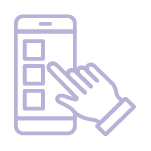Whether you’re working from home by choice or by necessity, make the most of your nbn™ connection – and workday – with these tips.
While working from home (WFH) has become increasingly common with those seeking flexibility in their careers, it’s likely never been a hotter topic of conversation than now. With the World Health Organization recently declaring the global coronavirus (COVID-19) outbreak a pandemic, the ability to work from home may soon become more necessity than a convenience. Some companies are already voluntarily asking their staff to work remotely, while those with suspected or confirmed cases of the COVID-19 virus are being advised to self-isolate. So, whether you need or want to work from home, we’ve compiled the following tips to help you make the most of the services over the nbn™ broadband access network*.
Getting the right speed
Depending on the nature of your work, you may be surprised at the download and upload requirements needed to effectively get the job done. Sending and receiving large files, taking video conference calls, and simultaneously running multiple online programs are just some of the typical work tasks that can affect internet speed. And if you work at night, remember that internet speeds tend to slow down in the after-dinner ‘busy period’.
Work from Home Tip: Talk to your phone and internet provider about the speed tiers available in your area*. If needed, consider speaking with your provider about changing your plan – even temporarily – to accommodate your working from home needs.
Getting the right plan
Working from home doesn’t have to be an isolating experience. Apps like Slack are useful for real-time team collaboration, while the likes of Trello can help with project management. For some virtual face-to-face time, try apps like Skype and Zoom, and share files over the cloud – including real-time document co-authoring and version control – with those including Google Docs and OneDrive. While undoubtedly handy, keep in mind that the more reliant your remote work is on internet-based software, the more bandwidth you may need. So, while sharing basic documents will have a relatively minor impact on your bandwidth, downloading and uploading massive files could have a noticeable effect.
Work from Home Tip: Ask your provider about the plans available to you. Tell them about the ways you’ll be using your connection for work and downtime so they can help you pick the right plan*.
Getting the optimum performance
Even with the right speed and plan, factors around the home can affect your online experience*. To help make the most of your workday, start by ensuring you have the best possible internet set-up in your home. Using Wi-Fi? Make sure your modem isn’t hiding behind the likes of brick walls, large electrical appliances or mirrors. These – and more – can cause poor signal. Living in a device-happy home? Basic modems can generally support eight devices connected at one time, so chat with your provider to make sure you have the right modem for your needs. Older cabling or devices at your place? These can lead to slower speeds. Get an assessment from a registered cabler and consider upgrading older devices, like printers or computers.
Work from Home Tip: Make sure your nbn™ connection has the chance to perform its best by following this list of tips to optimize your experience. https://www.youtube.com/watch?v=Xzu6EYikq8w
Internet down?
Many businesses use a Virtual Private Network (VPN) to allow their employees to log in remotely – and safely – to work servers and systems. If your internet appears to go down while working, it could be your VPN. To check whether it’s your VPN or an issue with your nbn™ connection, try accessing a non-work website like Google. If it loads normally, contacts your workplace to let them know your VPN isn’t working. You can also check if any unforeseen incident may be impacting your services over the nbn™ access network.
Your FAQs answered
The rollout of the nbn™ access network is more than 90 percent complete, meaning the vast majority of Australians already have access to a fast, reliable, secure wholesale broadband network.With more people working, studying and generally spending more time at home streaming content, we are seeing a change in the profile of data traffic on our network, with increasing residential usage of the network throughout the day and in the busy hours (7-11 pm).Like all infrastructure providers, NBN Co is actively working with retailers to ensure we optimize the network to support Australians in anticipation of unprecedented demand. As always, we encourage customers to contact their internet retailers to understand how their current plan will support their home working needs.
We continue to prioritize the health, safety, and wellbeing of our people including our external workforce and manage our Business Continuity planning, in response to COVID-19. Informed by the latest advice by Government and health authorities (including the WHO and Commonwealth Government), nbn has introduced additional health and safety procedures to support field technicians, including:
- Introducing an additional control whereby technicians are now required to implement a new ‘Call on approach’ procedure, verifying whether there is any reason to suspect risk of exposure to COVID-19 at the premises.
- Rescheduling of appointments if premises are in isolation.
- Issuing additional hygiene instructions and briefings.
- Providing additional hygiene products, including alcohol-based hand rub or hand soap, alcohol-based wipes and making face masks and disposable gloves available to all field technicians.
- Minimizing close contact when on-premises and exercising additional wipe downs of all equipment and touchpoints.
- In keeping with our obligations, continuing to maintain HSE Incident reports.
There are also a few practical tips to help people get the most out of their in-home-set-up:
- Keep your modem and Wi-Fi router in a central location, free from obstruction and away from interfering objects like televisions and microwave ovens.
- If you’re still not getting the performance you want, it may be that your Wi-Fi router could do with an upgrade.
- Check your plan and talk to your internet retailer about what you need.
There are also a few practical tips to help people get the most out of their in-home-set-up:
With the rollout of the national broadband network more than 90 percent complete, we have run an accompanying scheme to help with the migration to the nbn™ access network with customers who have medical alarms that have been registered with NBN Co.
We encourage residents to talk to their medical alarm provider and internet provider about their specific needs and we also provide a substantial resource on our website.
With the rollout of the national broadband network more than 90 percent complete, the nbn™ access network is contributing to education outcomes by helping to connect students and parents across the country with digital literacy and innovative learning tools.
We do anticipate that if schools are closed there will be an increase in the use of online tools to help students to continue with their classwork.
More students at home will change the profile of data traffic on the nbn™ access network, increasing residential usage of the network throughout the day and in the busy hours (7-11pm).
Like all infrastructure providers, NBN Co is actively working with retailers to ensure we optimize the network to support Australians in anticipation of unprecedented demand. As always, we encourage customers to contact their internet retailers to understand how their current plan would support their home working needs.
*An end user’s experience, including the speeds actually achieved over the nbn™ broadband access network, depends on the nbn™ access network technology and configuration over which services are delivered to their premises, whether they are using the internet during the busy period (typically, 7pm to 11pm), and some factors outside of nbn’s control (like their equipment quality, software, chosen broadband plan, signal reception, or how their provider designs its network). Speeds may also be impacted by the number of concurrent users on the Fixed Wireless network, particularly during busy periods. Sky Muster™ satellite users may experience latency.
Source: nbn





